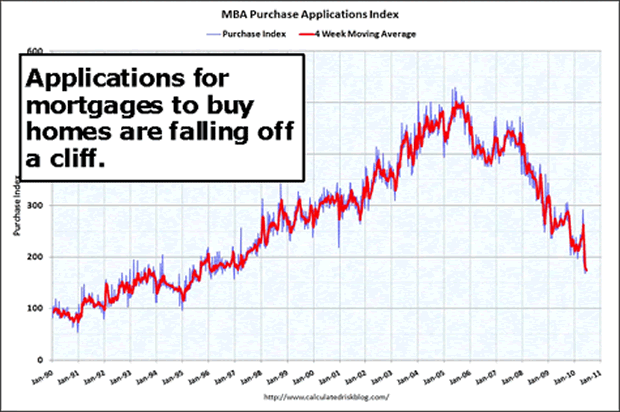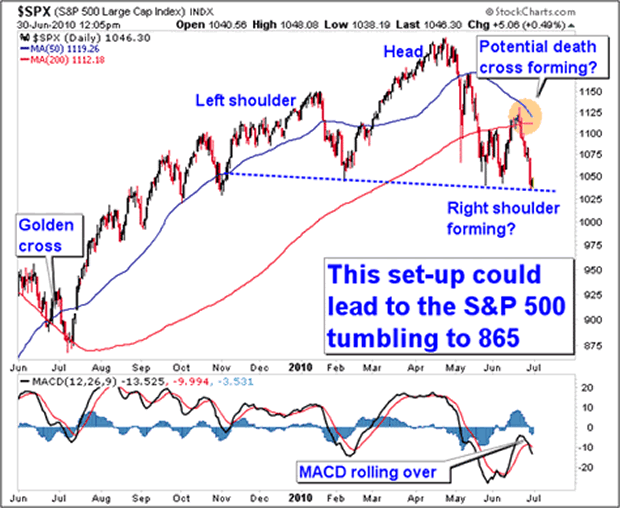Red Flags on the Economy, Stock Market Death Cross Forming
Stock-Markets / Stocks Bear Market Jul 02, 2010 - 08:47 AM GMTBy: Tony_Sagami
 The market seems to have run out of buyers. Recently, on days when the market goes up, the volume is light. On days when the market goes down, volume soars with passionate intensity.
The market seems to have run out of buyers. Recently, on days when the market goes up, the volume is light. On days when the market goes down, volume soars with passionate intensity.
The babbling heads on TV make the bullish case enough, so I’ll just summarize it: Basically, corporate profit margins surged to 36% in the first quarter. Since records began in 1947 they have never been this high. Meanwhile, bond yields are pitifully low. There is no better place, say bulls, to put your money than in the market’s leading stocks.
Maybe so. But let me give you a run-down on seven things that worry me … maybe they worry you. I think they explain why many investors aren’t willing to buy this recovery anymore. And I think these seven red flags indicate the next big move in the market may be down.
There are ways you can prepare for such a move. I’ll get to those in a bit. First, the bad news …
#1) China seems to be slowing down. An index of leading economic indicators in China rose by the smallest gain in five months in April. Since the world is counting on China’s go-go GDP to drive the global economy, that is a worrisome sign. Also, the Shanghai Composite Index recently hit its lowest level since April of last year. The Chinese aren’t feeling very bullish.
#2) Mortgage purchase applications are near a 13-year-low. So much for reinflating the housing bubble. Take a look at this chart from Calculated Risk …

As you can see from this chart, the purchase index has collapsed following the expiration of the tax credit. That suggests that home sales will fall sharply too. Home sales are a gauge of consumer confidence. People don’t buy homes if they don’t feel confident. Speaking of which …
#3) U.S. consumer confidence is plunging. U.S. consumers are increasingly worried about jobs and the economy, according to data from the Conference Board. Its consumer confidence index plummeted to 52.9 in June — the lowest level since March — from a downwardly revised 62.7 in May. What are people worried about? The future state of the economy and jobs, jobs, jobs!
So let’s look at jobs …
#4) U.S. employment continues to lag. Payroll company ADP said private employers added just 13,000 jobs in June. That’s well short of the 60,000 economists polled by Thomson Reuters forecast. The ADP report is often seen as a precursor to the Labor Department’s big monthly jobs report due out today.
Sure, earlier this month, the government reported that nonfarm payrolls grew by 431,000 in May. The bad news is most of the new jobs were temporary jobs at the U.S. Census. Private employers weren’t hiring. The government’s next payrolls report is due out Friday, and economists are actually expecting a contraction — a loss of 130,000 jobs.
#5) Impact from BP spill continues to grow. BP’s leaking “Well from Hell” in the Gulf of Mexico has economic as well as environmental impact. Louisiana’s fishing industry and oil industry is getting hammered. Florida’s $60-billion-a-year tourism industry is in danger. Texas is getting hit, too, because many of the deepwater oil rig crews live in that state.
In just the oil industry alone, pessimists estimate the drilling ban could cost all parties involved — companies, workers and support personnel — about a billion dollars a month. The optimists figure the cost is about half that. Either way, it’s a huge hit to the economy. And as long as the well isn’t capped, the damage will continue to grow.
#6) Massive budget crunch for America’s states. According to a new report from the Center on Budget and Policy Priorities, U.S. states in fiscal 2011 could be facing the worst budget situation since the recession began in 2007.
From Maine to California, states’ cumulative budget shortfall “will likely reach $140 billion in the coming year, the largest shortfall yet in a string of huge annual gaps that date back to the beginning of the recession,” the report says.
Since all states except Vermont have to balance their budgets, that means states are going to have to slash payrolls. This will worsen an already tough economic climate. Previously, states looked to the federal government to see them through tight budgetary times, but this time, Republicans and enough Democrats have united to say “no” to more federal money for state payrolls.
#7) The “Easy Money” days may be behind us. Governments around the world are tightening their belts. The G20 group of nations met in Canada recently, and pledged to slash deficits in half by 2013. The markets floated higher on a flood of easy money — if that flow of government money is drying up, markets could head lower.
Result: One Scary-looking Chart
They say that stocks “discount the future.” Well, the future they’re discounting right now is lousy. Across the major markets — the Dow, Nasdaq, and the S&P 500 — we are seeing chart action that indicates the rally may be ending and a tipping point may be coming up.
Look at this chart of the S&P 500 …

This is a busy chart. I’ll explain it from left to right, and top to bottom.
- The “Golden Cross” is the term market analysts use when the 50-day moving average crosses above the 200-day moving average. It’s an indicator of a change in trend. And you can see the market rallied nicely after that.
- Next we can see a potential head-and-shoulders pattern forming in the S&P 500. We need confirmation with a convincing close below the “neckline” of that pattern. It hasn’t happened yet. But there are some things that indicate this bearish move may be coming.
- First, we can see that 50-day moving average is moving lower — closer and closer to potentially crossing under the 200-day moving average. If that happens, it would be what technical analysts call a “Death Cross” — an indicator of a bearish change in the big trend.
- Second, look at the MACD indicator on the bottom of the chart. MACD is a trend-following momentum indicator. It is indicating that momentum is already turning bearish.
Nothing is written in stone. And to be sure, not all the economic news is bad. For example, the Chicago’s Purchasing Manager’s Index (PMI) data came out this week, and it showed that while manufacturing in the Chicago area slipped a tad in June (to 59.1 from 59.7) it remaining at relatively high levels.
So maybe all this bad news is priced into the market. That’s what the bulls are saying. Or maybe the bad news we’ve seen already is a harbinger of more bad news to come. But I think the bearish case is more likely. If this breakdown in the S&P 500 occurs, it would give us a target around 865. That’s a big move lower, and would tie in nicely with forecasts for a “double dip” in the economy.
The S&P 500 has pulled back quite a bit, and should bounce in this area. I would point out on that chart that I showed you earlier, even after the “Golden Cross” occurred, the market went lower for a brief while. So these things aren’t automatic triggers. Trends take time to form. I think the bullish trend in the S&P 500 may be over, or at least may need to take a breather for a while.
4 Ways to Protect Yourself and Your Portfolio
And that means you should consider turning more cautious in your portfolio. Here are some things to consider …
- Own Gold. If you haven’t already, start putting a small portion of your wealth in physical gold bullion — and silver, too. It will help safeguard you against the hard times that could be coming.
- Consider Funds That Let You “Short” the Major Indices. For example, the ProShares Short S&P 500 ETF (SH) aims to track the inverse of the daily movement in the S&P 500. Short funds aren’t for everybody, but they can function as a hedge for a portion of your portfolio.
- Leveraged Shorts if You Have an Appetite for Risk. There are funds that also track two or three times the inverse of the S&P 500 or other major indices. An example would be the ProShares UltraShort S&P 500 ETF (SDS). You have to be careful with these — have an exit point as well as a mental stop in mind BEFORE you put one dollar into this kind of fund — but if you have a stomach for risk and an appetite for larger returns, a leveraged inverse fund may be for you.
- Put the Right Stocks in Your Core Portfolio. I believe there are stocks that will likely hold up better than most on the way down and lead the charge on the next leg up. On the one hand, I like gold and silver miners. On the other hand, I like companies that pay big, fat dividends. They outperform in every recession — even bad ones. After the 1929 crash, it took the Dow Jones Industrial Average 25 years to get back to even. But at the same time, an investor who invested $100K and reinvested dividends would have seen his portfolio grow to $431K — a return of 331%.
If you’re in the market, you can’t just sit and hope things work out. You have to be proactive and prepare for the worst as well as the best. And now is the time to take action.
All the best,
Sean
P.S. My monthly publication, Crisis Profit Hunter is packed with dividend-paying stocks — as well as gold and silver picks. Plus, if you subscribe now, you can get a FREE copy of The Ultimate Suburban Survivalist Guide.
This investment news is brought to you by Uncommon Wisdom. Uncommon Wisdom is a free daily investment newsletter from Weiss Research analysts offering the latest investing news and financial insights for the stock market, precious metals, natural resources, Asian and South American markets. From time to time, the authors of Uncommon Wisdom also cover other topics they feel can contribute to making you healthy, wealthy and wise. To view archives or subscribe, visit http://www.uncommonwisdomdaily.com.
© 2005-2022 http://www.MarketOracle.co.uk - The Market Oracle is a FREE Daily Financial Markets Analysis & Forecasting online publication.



